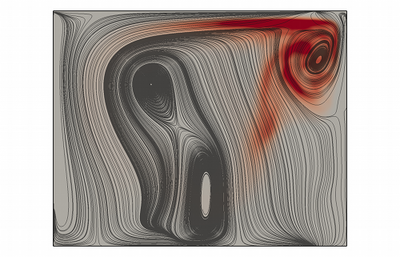Work in progress, come back later ! =)
Motivation
H-Allegro uses the compressible and reactive Navier-Stokes equations in order to solve two-phase combustion. It also takes into account a simplified chemistry of the reaction and the propagation of acoustic waves.
H-Allegro was developped by Eric Albin and Marianne Sjostrand.
Equations and Hypotheses
Equations
-
-
-
-
Hypotheses
The hypotheses to simplify the Navier-Stokes equations are :
- The total energy balance according to Poinsot-Veynante is described below, if :
The term can be ignored with regard to , which is the heat release due to combustion.
This release can be defined by these equations :
, where is the specific heat of reaction, is the standard enthalpy of formation and is the reaction rate.
is the power produced by volume forces on species k, considered as non-existent since there are no volume forces.
is the heat source term which is null here since there is no electric spark, laser or radiative flux.
is the mass fraction of the species k.
The tensor is composed of the tensor of constraints and the tensor of pressure :
Thanks to these hypotheses, the total energy balance becomes :
.
With corresponding to the heat release due to combustion, .
- The term is not used. It usually defines other forces like electromagnetical forces or weight.
- is either a fuel or a combustive source term.
if it is a fuel source term or if it is the oxidant one.
and are respectively the molar mass of fuel and oxidant.
- can be determined by the Arrhenius law :
- The heat flows due to mass fraction gradients and the species molecular distribution due to temperature gradients are neglicted (cf : Soret and Dufour).
- The termal conductivity, is given by :
Where is the Prandtl number :
This number compares the momemtum distribution with the heat distribution.
- The Lewis number for the species k, , is :
Where is the species diffusion.
We will consider the Lewis number egals to 1 in order to simplify the physics of the pre-mixture flame.
- The Schmidt number, , is :
- From the relation of these last three numbers, we can deduct that :
and
Therefore, the diffusion coefficient can be defined as :
- We use the Law of Fick which is a simplified diffusion law :
is the flux of particles density.
C is the particles density.
Thus the diffusion coefficients of the various species are characterized by the number of Lewis.
- We consider that the gas is a perfect, viscous, reagent and diatomic gas. As a consequence of the viscosity, the compressible effects are not dominating, which involves that the bulk viscosity is neglicted.
- The gas is reagent thus the mixture of various species is not isothermal, they must be individually followed. It implies that the calorific capacities depend on the temperature and on the composition.
- For a diatomic gas, the calorific capacities can be defined as follows :
- The gas respects the law of perfect gases :
- The combustion is an irreversible transformation whose creation of entropy is compensated with an entropy given by the system to the outside, because of a thermal transfer, thus we can consider that the transformation is isentropic. Consequently, the law of Laplace for the thermodynamics is applicable :
- According to the power law, the dynamic viscosity depends only on the temperature :
- The tensor of the constraints, by respecting the hypothesis of a Newtonian fluid, is :
The Kronecker symbol, , egals 1 if i=j, 0 else.
- The acoustic Reynolds number is defined such as :
c is the speed of sound : 340 m., L is the characteristic length and is the kinematic viscosity of air : 1.45e-5 m²..
Closure equations
-
-
-
-
-
-
Models
- Mixing : constant Schmidt number
- Chemistry : one step Arrhenius' law
Numerics
- Spatial : 6th-order finite difference scheme
- Temporal : 3rd order explicit time integration (Runge-Kutta3)
- Chemical :
- one step Arrhenius' law
- partially premixed gas
- Boundary conditions : the 3D-NSCBC processing, applied in a referential attached to the local streamlines.
Data Structures
- 1D, 2D, 3D structured solver
- Optimized non-blocking MPI communications
- Homogeneous mesh refinement
- VTK post-treatment possible
- Unformatted Fortran90 format data files
Software Engineering
Gallery
Performances
